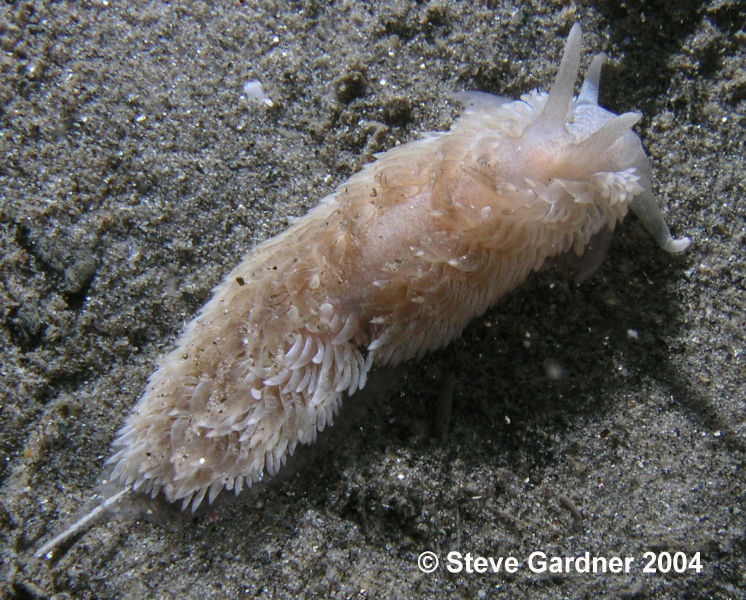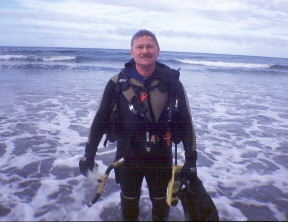 |
Aeolidia papillosa
Photo courtesy of Steve GardnerPhoto taken at La Jolla Shores, La Jolla, Calif
Aeolidia papillosa (Linnaeus, 1761)
Aeolidea papillosa is one of the most common and overlooked aeolid species along the Pacific Coast of North America. In fact is common throughout all temperate waters of the northern hemisphere, and it has now even been reported from the southern tip of South America. They are overlooked because unless you come upon a specimen crawling out in the open as Steve has captured here, they are quite cryptic on their sea anemone prey.
I will never forget a dive I made inside the Morro Bay estuary under the Coast Guard pier there. The pier pilings were fully covered with the plumose sea anemone, Metridian senile . In this embayment this anemone is the favorite food of Aeolidia and that day I observed 100's if not 1000's of individuals feeding of these white cnidarians.
But this aeolid feeds on any number of sea anemone species, depending upon which ocean you are in. In California I have observed it feeding on Epiactis as well as Metridian . In the UK it feeds on the green beadlet anemone, Actinia equina, and Sagartia troglodytes . In the White Sea they feed on Bunodactis stella. On the eastern seaboard of the US it feeds on Urticina felina.
As seen in other species, the color of the slug often is related to the color of the anemone species it has recently fed upon. In California when Aeolidia feeds on Metridian it is white, while species feeding on Epiactis are a darker gray almost greenish gray color. Examples of this species wide variation in color can be seen on Bill Rudman's Sea Slug Forum for specimens from the East Coast of the US and Europe.
Aeolidia papillosa has been called the 'maned nudibranch' because of its dense cloak of cerata, which cover the body and extend anterior of the rhinophores. Obviously Linnaeus gave it the name 'papillosa' because of this characteristic. The egg masses of this species are also commonly found nearby on the anemones substrate. The mass is undulating coiled chain of egg packets. Egg color varies from white to pink and orange.
Danville, Calif
Mar. 2004
Steve Gardner at La Jolla Shores

I asked Steve to give slug site readers an insight to his experience with his new Olympus 5050Z digital camera. The following is his reply: "... I have a Olympus 5050Z camera housed in a Ikelite Digital housing. Two Ikelite DS50 strobes were included with the TTL package. This system uses slave sensors to fire the strobes. There is no direct connection through the housing to the strobes. I shot the Armina californica photos in the Super Macro mode in Manual with the all time Auto Focus on. An F Stop setting of 8 (the highest setting available) at 100th of a second was used in conjunction with an ISO setting of 100. The Super Macro is really great and allows me to nearly touch the subject and still get the photo. If I were not using my two external strobes, I would not get an image as the onboard strobe gets blocked by the lens. Digital Photography is definitely challenging. I have had trouble getting the lighting right but I am improving. Having instant images displayed really helps in making changes to the lighting and composition ..."
Send Steve mail at stevebumblebee@san.rr.com |
Taxonomic information courtesy of:

David W. Behrens
Author:
Pacific Coast Nudibranchs
Send Dave mail at dave@seachallengers.com
|
